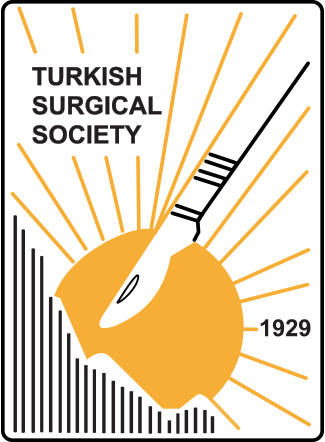Abstract
Purpose: Wound healing is a well-organized reparation process that develops after an operation or trauma. Healing process can be disturbed due to various factors. Decreased blood supply and subsequent hypoxia are some main factors. This interrupted process can frequently happen during diabetes and, decubitus and venous ulcers. In this study we aimed to observe the effects of nicotinamide and acetyl cysteine over chronic wound healing in topical applications.
Patients and Methods: Forty five Sprague-Dawley male rats are used in this study. Control, acetyl cysteine and nicotinamid groups are divided into three sub groups, as wound tissues to be obtained in 3rd, 5th and 8th days. A 6 mm punch biopsy was performed under anesthesia, to create a total of 6 excisional skin wounds on the bipedicular flaps at the dorsal side of each animal. On these ischemic skin wounds 50 mg/kg acetyl cysteine and 100 mg/kg nicotinamide was applied b.i.d. for 7 days. At 3rd, 5th and 8th days, the degree of healing was assessed by wounds' surface area measurements and histopathological evaluation.
Results: In the histopathological assessments performed in 3rd, 5th and 8th days, it is found that the groups in which nicotinamide and acetyl cysteine were applied had less inflammatory cell numbers but more fibroblasts and collagen synthesis, in comparison to the control groups. Similar to the histopathological findings, a significant decrease was observed in the wounds' surface areas measured on a daily basis.
Conclusion: We demonstrated in this study that nicotinamide and acetyl cysteine molecules which are known to be effective antioxidants affect the chronic wound model positively and accelerate the recovery process.
Keywords:
Wound healing, nicotinamide, acetyl cysteine, chronic wound
References
1Mustoe TA, O'Shaughnessy K, Loeters O. Chronic wound pathogenesis and current treatment strategies: a unifying hypothesis. Plast Reconstr Surg 2006;117: 35-41.
2Hutton J, Tappel A, Undenfried S. Cofactor and substrate requirements of collagen proline hydroxylase. Arch Biochem Biophys 1967;118:231-240.
3Medina A, Scott PG, Ghahary A, Tredget EE. Pathophysiology of chronic nonhealing wounds. J Burn Care Rehabil 2005;26:306-319.
4Bulger EM, Maier RV. Antioxidants in critical illness. Arch Surg 2001;136:1201- 1207.
5Millea PJ. N-acetylcysteine: multiple clinical applications. Am Fam Physician 2009;80:265-269.
6Ying W. NAD+/NADH and NADP+/ NADPH in cellular functions and cell death: regulation and biological consequences. Antioxid Redox Signal 2008;10:179-206
7Schwarz DA, Lindblad WJ, Rees RS. Altered collagen metabolism and delayed healing in a novel model ischemic wounds. Wound Rep Reg 1995;3:204-
8Tas C, Ozkan CK, Savaser A, Ozkan Y, Tasdemir U, Altunay H. Nasal absorption of metoclopramide from different Carbopol 981 based formulations: In vitro, ex vivo and in vivo evaluation. Eur J Pharm Biopharm 2006;64:246-254.
9Adamson B, Schwarz D, Klugston P, Gilmont R, Perry L, Fisher J, Lindblad W, Rees R. Oxidant stress: the role of the glutathione redox cycle in skin preconditioning. J Surg Res 1996;62:159-164.
10Mustoe T. Understanding chronic wounds: a unifying hypothesis on their pathogenesis and implications for therapy. Am J Surg 2004;187:65–70.
11Saarialho-Kere UK. Patterns of matrix metalloproteinase and TİMP expression in chronic ulcers. Arch Dermatol Res 1992;290:47-54.
12Kull F, Brent DA, Parikh I, Cuatrecasas P. Chemical identification of a tumor derived angiogenic factor. Science 1987;236:843-845.
13Collins TM, Denish A, Sheffield J, Mitra A, Stueber K, Smith YR. Nicotinamide enhances skın flap survıval. Scand J Plast Reconstr Surg 1989;23:177-179.
14Collins TM, Caimi R, Lynch PR, Sheffield J, Mitra A, Stueber K, Smith YR. The effects of nicotinamide and hyperbaric oxygen on skin flap survival. Scand J Plast Reconstr Surg Hand Surg 1991;25:5-7
15Walsh TS, Lee A. N-acetylcysteine administration in the critically ill. Intensive Care Med 1999;25:432-4.
16Gillissen A, Nowak D. Characterization of N-acetylcysteine and ambroxol in antioxidant therapy. Respir Med 1998;92:609– 623.
17Broughton G , Janis JE, Attinger CE: The basic science of wound healing. Plast Reconstr Surg 2006;117:12-34.
18Broughton G, Janis JE, Attinger CE. Wound healing: an overview. Plast Reconstr Surg 2006;117:1-32.
19Steiling H, Munz B, Werner S, Brauchle M. Different types of ROS-scavenging enzymes are expressed during cutaneous wound repair. Exp Cell Res, 1999, 247:484-494.
20Rees RS, Smith DJ, Adamson B, Im M, Hinshaw D. Oxidant stres: the role of glutathione redox cycle in skin preconditioning. J Surg Res 1995;58:395-400.
21Chen C, Schultz GS, Bloch M, Edwards PD, Tebes S, Mast BA. Molecular and mechanistic validation of delayed healing rat wounds as a model for human chronic wounds. Wound Repair Regen 1999;7:486-494.
22Kabali B, Girgin S, Gedik E, Ozturk H, Kale E, Buyukbayram H. N-Acetylcysteine prevents deleterious effects of ıschemia/reperfusion ınjury on healing of colonic anastomosis in rats. Eur Surg Res 2009;43:8–12
23Aldavood SJ, Behyar R, Sarchahi AA, Rad MA, Noroozian I, Ghamsari SM, Sadeghi- Hashjin G. Effect of acetylcysteine on experimental corneal wounds in dogs. Ophthalmic Res 2003;35:319-323.
24Kunnavatana SS, Quan SY, Koch RJ. Combined effect of hyberbaric oxygen and N-acetylcysteine on fibroblast proliferation. Arch Otolaryngol Head Neck Surg 2005;131:809-814.
25Broughton G , Janis JE, Attinger CE. The basic science of wound healing. Plast Reconstr Surg 2006;117:12-34.



